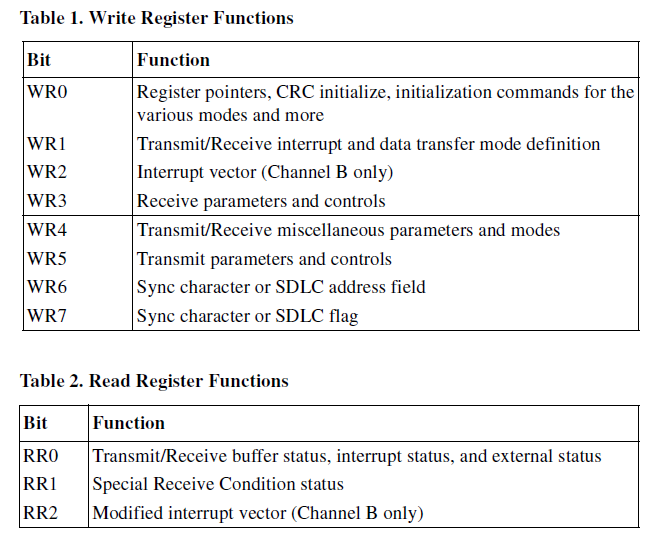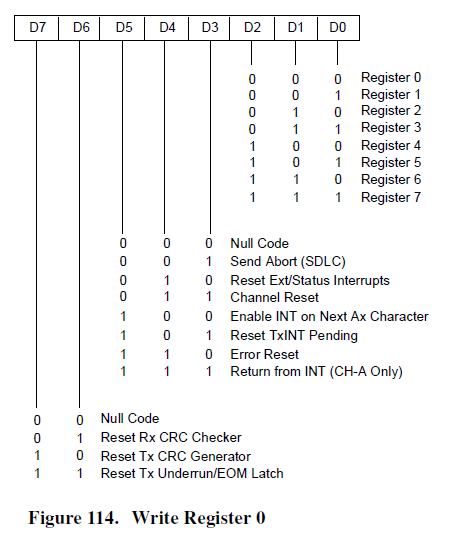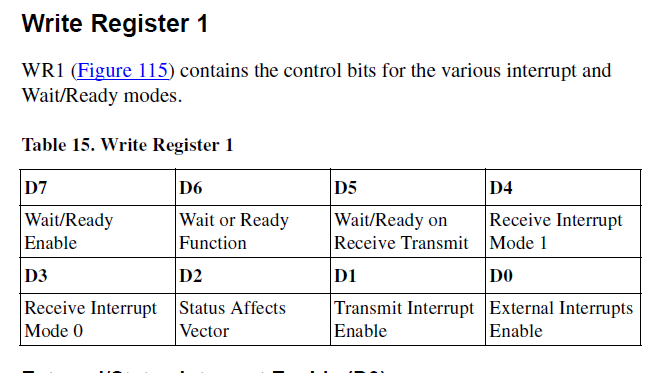SPoC Code Side
The PSoC will need to poll the IO_Stat_Reg and wait until it sees IORQ* asserted along with either CPURD* or CPUWR*. It should then read the AdrLowIn status register. Using this information, the PSoC should then perform the IO operation.
The main( ) code is actually not idle. It's essentially polling the USB interface. I think the USB is interrupt driven so the code probably just interacts with the handshake to the interrupt. It is currently configured to loop back USB data from the receive to the transmit. I can see this on the PC when I connect to the card using PuTTY. Whatever I type gets echoed back. This will need to be intercepted and routed to the Z80 via the SIO interface.
Data, Status and Ports
There are four pins provided for an external UART, but I'm going to just toss out the SIO data from the second part for the moment. Using the PSoC debugger to single step, the first write is to the SIO A Control Register with a value of 0. This matches the ASM code.
0403 01A6 3E 00 LD A,$00 0404 01A8 D3 02 OUT (SIOA_C),A 0405 01AA 3E 18 LD A,$18 0406 01AC D3 02 OUT (SIOA_C),A
SIO Data Sheet
This is when looking at the SIO data sheet comes into play. What does a write to the control register with a value of 0x0 do in the SIO?
The SIO is described in the document Z8420 Peripheral User Manual um0081 starting on p207. There's a lot of information in there about all of the modes that the SIO can do.
Grant's schematic connects the interrupt line from the SIO to the Z80 but that, by itself doesn't mean it is interrupt driven. The Monitor Code has the following:
0139 0062 ;------------------------------------------------------------------------------ 0140 0062 ; Serial interrupt handlers 0141 0062 ; Same interrupt called if either of the inputs receives a character 0142 0062 ; so need to check the status of each SIO input. 0143 0062 ;------------------------------------------------------------------------------ 0144 0062 F5 serialInt: PUSH AF 0145 0063 E5 PUSH HL
So, it looks like the hardware and code support interrupts. It looks like there may only be a receive buffer so the interrupts may only be on receive characters. I will have to dig deeper to see if that is the case. It does make sense to have interrupts on receive and wait on output since the buffer could just back up on the transmit side anyway if the host is not ready.
If it's the case that there's only input interrupts then I should be able to get outputs running without worrying about interrupt handling. The console output routine also seems to be polled and waits until the transmit is ready.
0287 0124 ;------------------------------------------------------------------------------ 0288 0124 ; Console output routine 0289 0124 ; Use the "primaryIO" flag to determine which output port to send a character. 0290 0124 ;------------------------------------------------------------------------------ 0291 0124 F5 conout: PUSH AF ; Store character 0292 0125 3A 8A 40 LD A,(primaryIO) 0293 0128 FE 00 CP 0 0294 012A 20 0D JR NZ,conoutB1 0295 012C 18 01 JR conoutA1 0296 012E conoutA: 0297 012E F5 PUSH AF 0298 012F 0299 012F CD 42 01 conoutA1: CALL CKSIOA ; See if SIO channel A is finished transmitting 0300 0132 28 FB JR Z,conoutA1 ; Loop until SIO flag signals ready 0301 0134 F1 POP AF ; RETrieve character 0302 0135 D3 00 OUT (SIOA_D),A ; OUTput the character 0303 0137 C9 RET ... 0314 0142 ;------------------------------------------------------------------------------ 0315 0142 ; I/O status check routine 0316 0142 ; Use the "primaryIO" flag to determine which port to check. 0317 0142 ;------------------------------------------------------------------------------ 0318 0142 CKSIOA 0319 0142 97 SUB A 0320 0143 D3 02 OUT (SIOA_C),A 0321 0145 DB 02 IN A,(SIOA_C) ; Status byte D2=TX Buff Empty, D0=RX char ready 0322 0147 0F RRCA ; Rotates RX status into Carry Flag, 0323 0148 CB 4F BIT 1,A ; Set Zero flag if still transmitting character 0324 014A C9 RET
The PSoC USB interface ought to be significantly faster than a Serial UART.
Some things, like bits per character, stop bits, parity don't matter for the USB-Serial interface since it's automatically taken care of by the USB transport so writes to those control values can be safely ignored (at least for the USB-Serial port). They will probably need to be taken into account for the 2nd UART interface, but a lot of that is easily handled by the PSoC UART code.
As a side note: M1* will matter when it comes to handling interrupts (from the SIO datasheet)
M1 Machine Cycle One (input from Z80 CPU, active Low). When M1 is active and RD is also active, the Z80 CPU is fetching an instruction from memory; when M1 is active while IORQ is active, the Z80 SIO accepts M1 and IORQ as an interrupt acknowledge if the Z80 SIO is the highest priority device that has interrupted the Z80 CPU.
Hardware handshake is also not an issue for the USB-Serial port since it's also taken care of by the USB protocol.
The SIO datasheet shows that there are multiple registers which apparently are selected by a write to the first location.

These registers can be represented in C by variables.
WR0

WR1:

Re-writing Grant's SIO initialization code as psuedo-code:
; SIO Initialization code in Grant's monitor ; Set up Port A SIOA_C = $00 ; WR0 SIOA_C = $18 ; Channel A reset SIOA_C = $04 ; Select WR4 SIOA_C = $C4 ; X64 clock rate, 1 stop bit, no parity SIOA_C = $01 ; Select WR1 SIOA_C = $18 ; Rx int on all rx chars, no Tx int enable SIOA_C = $03 ; Select WR3 SIOA_C = $E1 ; 8 bits/char, auto enable CTS, Rx Enable SIOA_C = $05 ; Select WR5 SIOA_C = RTS_LOW ; RTS = LOW ; Set up Port B SIOB_C = $00 ; Select WR0 SIOB_C = $18 ; Channel A reset SIOB_C = $04 ; Select WR4 SIOB_C = $C4 ; X64 clock rate, 1 stop bit, no parity SIOB_C = $01 ; Select WR1 SIOB_C = $18 ; Rx int on all rx chars, no Tx int enable SIOB_C = $02 ; Select WR2 is Interrupt Vector Register SIOB_C = $60 ; INTERRUPT VECTOR ADDRESS Value SIOB_C = $03 ; Select WR3 SIOB_C = $E1 ; 8 bits/char, auto enable CTS, Rx Enable SIOB_C = $05 ; Select WR5 SIOB_C = RTS_LOW ; RTS = LOW
I think I could simply ignore any writes to the control registers since I know what they do in Grant's code. This isn't a general purpose emulator, but I don't need to support many of the SCC modes. A more general purpose emulator would need to deal with changes to the registers. All I really need to know is:
- Receive characters are interrupt driven
- Transmit characters are directly written by polling status and then writing
The one thing I do need is the WR2 value since it provides the interrupt vector address. This get supplied back to the Z80 in response to an interrupt acknowledge cycle.
Another possibility is to hard code the fact that these accesses have to come in pairs. The first access is the offset to the register in the second access. I could stuff away the register values based on the second access and hard code this as pairs in the SIO emulator. This seems like the best choice.
 land-boards.com
land-boards.com
Discussions
Become a Hackaday.io Member
Create an account to leave a comment. Already have an account? Log In.